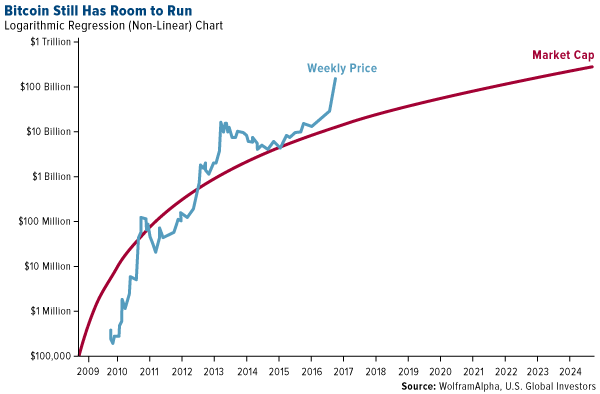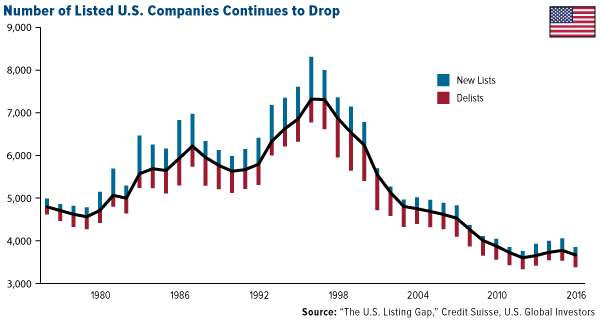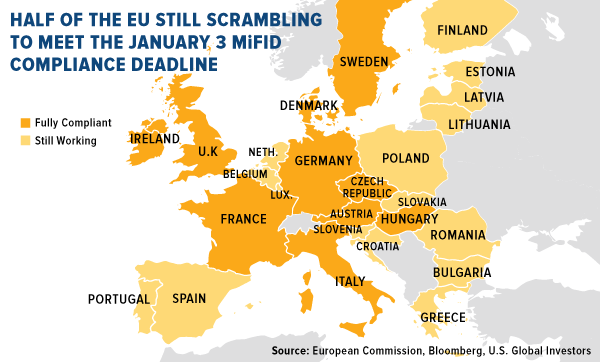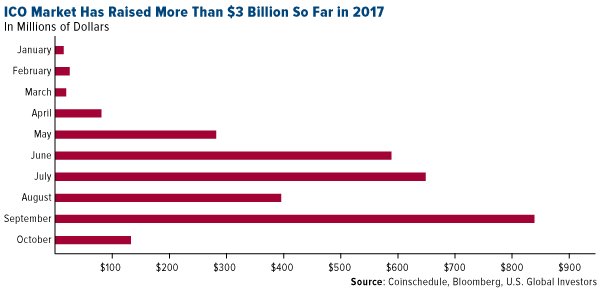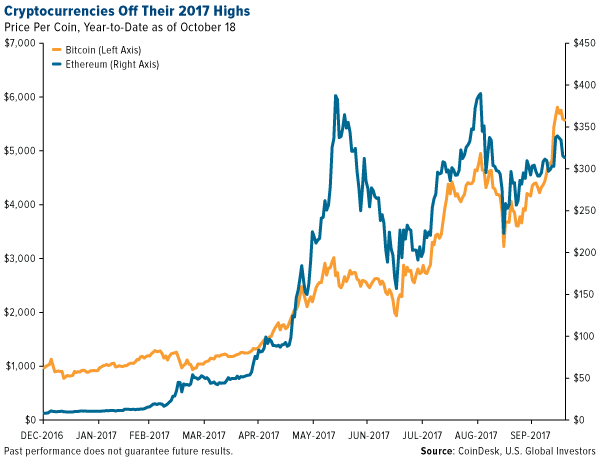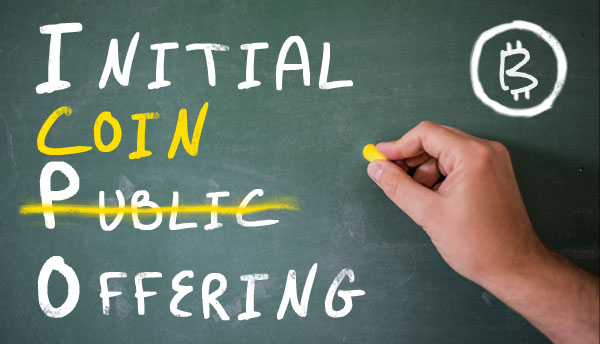
Last week I was in Barcelona speaking at the LBMA/LPPM Precious Metals Conference, which was attended by approximately 700 metals and mining firms from all over the globe. I found the event energizing and stimulating, full of contrary views on topics ranging from macroeconomics to physical investment markets to cryptocurrencies.
My keynote address focused on quant investing in gold mining and the booming initial coin offering (ICO) market. I’m thrilled to share with you that the presentation was voted the best, for which I was awarded an ounce of gold. I want to thank the London Bullion Market Association, its members and conference attendees for this honor.
Speaking of gold and cryptocurrencies, the LBMA conducted several interesting polls on which of the two assets would benefit the most in certain scenarios. In one such poll, attendees overwhelmingly said the gold price would skyrocket in the event of a conflict involving nuclear weapons. Bitcoin, meanwhile, would plummet, according to participants—which makes some sense. As I pointed out before, trading bitcoin and other cryptos is dependent on electricity and WiFi, both of which could easily be knocked out by a nuclear strike. Gold, however, would still be available to convert into cash.
It’s a horrific thought, but the poll results show that the investment case for gold as a store of value remains favorable. Goldman Sachs echoed the idea last week, writing in a note to investors that “precious metals remain a relevant asset class in modern portfolios, despite their lack of yield.” The investment bank added that precious metals “are still the best long-term store of value out of the known elements.”
Metcalfe’s Law Suggests Crypto Prices Could Keep Rising
This isn’t meant to knock bitcoin and other virtual currencies. Because they’re decentralized and therefore less prone to manipulation by governments and banks—unlike paper money and even gold—I think they could also have a place in portfolios.
Even those who criticize cryptocurrencies the loudest seem to agree. JPMorgan Chase CEO Jaime Dimon, if you remember, called bitcoin “stupid” and a “fraud,” and yet his firm is a member of the pro-blockchain Enterprise Ethereum Alliance (EEA). Russian president Vladimir Putin publicly said cryptocurrencies had “serious risks,” and yet he just called for the development of a new digital currency, the “cryptoruble,” which will be used as legal tender throughout the federation.
Follow the money.
Metcalfe’s law states that the bigger the network of users, the greater that network’s value becomes. Robert Metcalfe, distinguished electrical engineer, was speaking specifically about Ethernet, but it also applies to cryptos. Bitcoin might look like a bubble on a simple price chart, but when we place it on a logarithmic scale, we see that a peak has not been reached yet.
Bitcoin adoption could multiply the more people become aware of how much of their wealth is controlled by governments and the big banks. This was among the hallway chatter I overheard at the Precious Metals Conference, with one person commenting that what’s said in private during International Monetary Fund (IMF) meetings is far more important than what’s said officially.
I have a similar view of the G20, whose mission was once to keep global trade strong. Since at least 2008, though, the G20 has been all about synchronized taxation to grow not the economy but the role government plays in our lives. Trading virtual currencies is one significant way to get around that.
The Incredible Shrinking IPO Market
Just as water takes the path of least resistance, money flows where it’s respected most.
You need only look at the mountain of cash U.S. multinationals have stashed overseas, currently standing at an estimated $2.6 trillion. The steep 39 percent U.S. corporate tax rate—the highest among any country in the Organization for Economic Cooperation and Development (OECD)— discourages companies from bringing their profits back home and reinvesting them in new equipment and employees.
Of course, taxes aren’t the only type of friction money can run up against. More and more stringent financial rules and regulations have been one of the top destroyers of capital and business growth over the past 20 to 30 years. The Sarbanes-Oxley Act, signed in 2002, is widely blamed for limiting the number of initial public offerings (IPOs) that occur in the U.S. The legislation has made it prohibitively expensive for many smaller firms to get listed on an exchange. Between 1996 and 2016, the number of investable U.S. companies was cut in half, falling from 7,322 to 3,671.
This has ultimately hurt everyday retail investors who not only have fewer stocks to invest in now but also lack access to many of the same potentially profitable opportunities enjoyed by angel investors, venture capitalists and other institutional investors. Private equity and venture capital can be much higher-yielding investments than common asset classes such as Treasuries and equities, but for the most part, only accredited investors can participate.
Bracing for MiFID
IPOs could be squeezed even further after the implementation of the European Union’s (EU) revised Markets in Financial Instruments Directive (MiFID), set to go into full effect January 3. The directive, initially passed in response to the financial crisis, acts as a sweeping reformation of existing trading rules that affect everything from stocks to bonds to commodities. All 28 EU nations must have laws in place to comply with MiFID by the January deadline—or face litigation and fines.
With less than two months left on the clock, 17 countries, including Spain, Portugal and the Netherlands, are still scrambling to convert MiFID into national law, according to Bloomberg. This is creating all sorts of financial uncertainty for banks, insurers and money managers on both sides of the Atlantic.
One rule in particular could threaten U.S. IPOs. It states that, to be more transparent, banks must now “unbundle” the costs of investment research from that of executing trades, a practice that’s been routine for decades. To produce stand-alone research, banks must register as investment advisers, a costly process that might prompt some firms to avoid it altogether. This would limit investors’ exposure to only the largest companies and, in turn, discourage smaller U.S. firms from pursuing an IPO, according to Cowen & Co. analysis and reported by Bloomberg.
MiFID is just the latest in a long string of regulations that, while conceived with good intentions, carry unintended consequences. It’s doubly unfortunate that an EU rule could so impact U.S. companies’ ability to gain the publicity necessary to go public.
But hasn’t this been the trend for years now? In many ways, doing business in the EU has only gotten more challenging, and bureaucrats seem determined to take punitive steps against successful American firms.
Look at how Facebook, Google and other large tech companies have been treated in Europe. Back in June, the search giant was slapped with a record $2.8 billion antitrust fine and has since been strongarmed into changing its online shopping service.
A restrictive regulatory backdrop is largely responsible for this. Because rules are so tight, European companies have a hard time innovating and staying competitive. So instead of building its own Facebook or Google, the EU’s only other recourse is to take a protectionist approach and wrap the 28-member bloc in more and more red tape.
For Many Startups, ICOs Are a Solution
I believe this is part of the reason why we’re seeing such a massive surge in ICOs, which, at the moment, are nearly unregulated in the U.S. and Europe. In an effort to bypass the rules and costs associated with getting listed on an exchange, many startups now are opting to raise funds by issuing their own digital currency based on blockchain technology. And unlike with private equity, smaller retail investors can participate.
Again, money flows where it’s respected most.
Bitcoin and Ethereum are the best known cryptocurrencies, but there are more than 1,000 being traded around the world, with a combined market cap of around $150 billion, according to Bank of America Merrill Lynch (BoAML).
As of this month, IPOs have raised over $3 billion in 2017, more than seven times the amount generated in all years prior to 2017 and far surpassing expectations of around $1.7 billion for the year.
To give you some perspective, the U.S. IPO market raised $4.1 billion from 29 deals in the September quarter alone, according to Renaissance Capital. Although this dwarfs the ICO market in dollar terms, both the number of IPOs and the amount raised are significantly lower than the same quarter in 2014, which saw an impressive $37.6 billion raised from 60 deals.
As long as the barriers to getting listed remain high, I expect we’ll see this trend of fewer IPOs and more ICOs continue.
Bitcoin Now Bigger than Goldman Sachs
Not all cryptocurrencies will survive, obviously, and we’ll likely see huge transformations in the space before clear leaders pull away from the pack. Remember, no one knew in 1997 which internet companies would eventually dominant the others.
But for now, it’s an exciting time for an asset class that didn’t even exist 10 years ago. Trading above $6,000 for the first time last week, bitcoin reached a market cap of $96.7 billion. Amazingly, that’s more than Goldman Sachs’ market caps of $92.9 billion.
It’s important for investors to know that cryptos do face potential regulation risk. What kind of risk, though, is currently up in the air as U.S. regulators debate whether digital currency is a security or commodity. One would place it within the jurisdiction of the Securities and Exchange Commission (SEC), the other within the jurisdiction of the Commodity Futures Trading Commission (CFTC). Unsurprisingly, both agencies see cryptos as their own.
Last week also highlighted a new risk in the fledgling market. Tezos, the firm behind what was at the time the largest ICO in history, revealed a significant slowdown in the progress of its virtual coin, the “tezzie.” Back in July, Tezos made headlines for raising a then-unprecedented $232 million. But today, the group, headed by a husband-and-wife duo, is faced with a number of setbacks including a lack of developers and a highly-publicized management dispute.
According to the Wall Street Journal’s Paul Vigna, this has “put trading of Tezos tokens held by investors in limbo while also putting some of the technology on hold as well.”
Diwali Fails to Light Up Gold
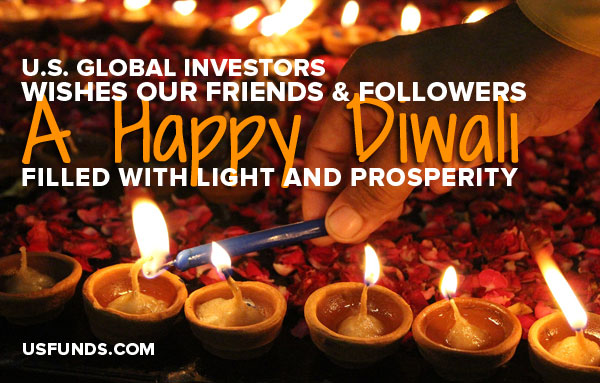
Turning to gold, the yellow metal made healthy gains the week before last, climbing more than 2.3 percent as we headed closer to the first day of Diwali. As I’ve explained numerous times before, it’s considered auspicious to give gifts of gold bullion and jewelry during the Hindu Festival of Lights, and in years past we’ve seen some price appreciation in the days and weeks leading up to the celebration.
Last week, though, the gold price fell below $1,300 an ounce as stocks continued their record-setting bull run.
But as the LBMA poll shows, it’s prudent to have some gold in your portfolio, as it’s negatively correlated with other assets. As always, I recommend a 10 percent weighting, with 5 percent in physical gold and 5 percent in gold stocks, and remember rebalance every year.
All opinions expressed and data provided are subject to change without notice. Some of these opinions may not be appropriate to every investor. By clicking the link(s) above, you will be directed to a third-party website(s). U.S. Global Investors does not endorse all information supplied by this/these website(s) and is not responsible for its/their content.
Holdings may change daily. Holdings are reported as of the most recent quarter-end. None of the securities mentioned in the article were held by any accounts managed by U.S. Global Investors as of 9/30/2017.


